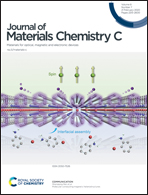Non-toxic green food additive enables efficient polymer solar cells through adjusting the phase composition distribution and boosting charge transport†
Abstract
Solvent additives play an important role in optimizing the morphology of the photoactive layer and improving the photovoltaic performance of polymer solar cells (PSCs). However, the toxicity of common additives to the environment limits their further application in photovoltaic cells. Herein, a non-toxic green food additive, benzyl salicylate (BS), was introduced as a novel solvent additive into inverted PSCs based on ITO/ZnO/PTB7-Th:PC71BM/MoO3/Ag. Subsequently, the effect of BS on the photovoltaic performance was studied, and the best power conversion efficiency (PCE) of 9.43% was achieved when adding 2% BS into the photoactive layer of PSCs. Furthermore, the PSCs treated by 1–4% BS all exhibited good photovoltaic performance compared to that using 3% DIO (8.56%), which demonstrated that the universality was very strong. In addition, a good solubility for fullerenes was presented on BS like DIO, which was determined by atomic force microscopy and transmission electron microscopy. The water contact angle and time-off flight secondary ion mass spectroscopy results manifested that the good solubility of high-boiling-point additive BS to PC71BM could boost the phase composition distribution at the surface and in the vertical direction. Thus, an efficient route for exciton dissociation and charge transfer could be formed when the PSC was processed via 2% BS, which could also be ascertained by space charge limited current, impedance spectroscopy. The present research findings provide useful information for realizing large-area PSC fabrication, where a greener non-toxic additive is always preferred.

- This article is part of the themed collection: Journal of Materials Chemistry C Lunar New Year collection 2021


 Please wait while we load your content...
Please wait while we load your content...